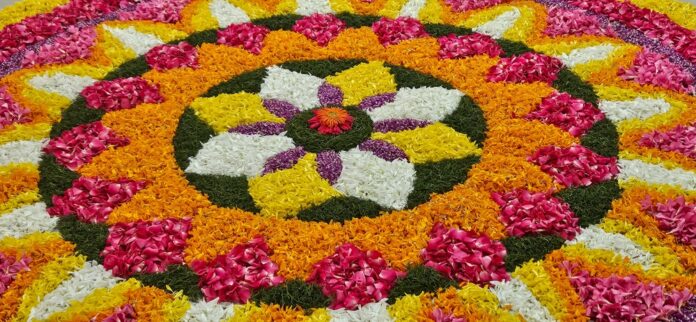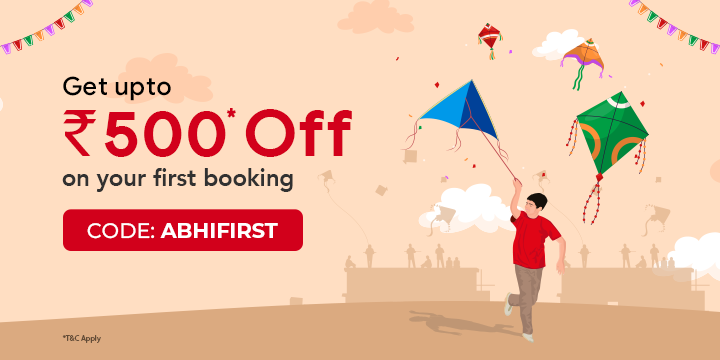Table of Contents
ToggleList of Onam Celebration Names
Onam, one of the most prominent festivals in Kerala, is a celebration that embodies the culture, tradition, and spirit of the Malayali people. It marks the homecoming of King Mahabali and is observed for ten days during the Malayalam month of Chingam (August-September). Each day of the Onam festival has its name and significance, reflecting various traditional rituals, cultural events, and feasts. The festival showcases the best of Kerala’s rich heritage through dance, music, games, and, most famously, the grand feast called Onam Sadya.
Also Read: Onam Festival 2024: Know All About Festival of Kerala
In this blog, we will explore the names and importance of each day of the Onam celebration, offering a detailed guide to the customs and rituals that make this festival unique.
1. Atham (Day 1)
The first day of the Onam celebration is known as Atham, and it marks the beginning of the festivities.
- Pookkalam: The traditional floral carpet, called Pookkalam, starts small on Atham and grows in size each day until Thiruvonam, the main day of Onam. It is a symbol of joy and prosperity.
- Processions: The famous Athachamayam procession takes place in Thrippunithura. It features caparisoned elephants, folk dancers, and music, and symbolizes the march of King Mahabali.
- Spiritual Preparation: People begin cleaning their homes, wearing new clothes, and making preparations for the upcoming days.
Atham sets the tone for the Onam festival, bringing families and communities together in a spirit of unity and celebration.
2. Chithira (Day 2)
Chithira is the second day of Onam, and it is dedicated to cleaning and decorating.
- Pookkalam Addition: More flowers are added to the Pookkalam, and intricate designs are created to enhance its beauty.
- House Cleaning: Homes are thoroughly cleaned and adorned with traditional decorations to welcome the harvest season.
- Prayers: Devotees visit temples to offer prayers for peace and prosperity.
Chithira emphasizes cleanliness and purity, preparing the household for the rest of the festival.
3. Chodhi (Day 3)
Chodhi is the day when the Onam shopping begins in full swing.
- New Clothes: People purchase new clothes, jewelry, and gifts for themselves and their loved ones, an integral part of Onam celebrations.
- Traditional Attire: Men typically wear mundu, while women wear kasavu sarees (white sarees with golden borders), symbolizing Kerala’s cultural richness.
- Shopping: Markets are bustling with people buying festival-related items such as flowers for Pookkalam, ingredients for the grand feast, and decorative items for the home.
Chodhi is all about festivity and indulgence as families prepare for the upcoming grand celebrations.
4. Visakam (Day 4)
Visakam marks the day when the preparations for the grand Onam Sadya (feast) begin.
- Sadya Preparations: People start procuring ingredients and making pre-cooked items for the Onam Sadya, which will be served on Thiruvonam.
- Floral Competitions: In some areas, competitions for the most beautiful Pookkalam are held, encouraging community participation.
- Special Offerings: Families visit temples to offer prayers and special offerings for a bountiful harvest.
Visakam represents the onset of the feast preparations, one of the most cherished aspects of Onam.
5. Anizham (Day 5)
Anizham is the day associated with the famous Vallamkali (boat race), a traditional event that is closely tied to the Onam celebration.
- Vallamkali (Snake Boat Race): The Nehru Trophy Vallamkali is one of the most anticipated events of Onam, where beautifully decorated snake boats compete in backwater rivers. It is a spectacle of strength, coordination, and traditional maritime culture.
- More Pookkalam: Pookkalams grow larger and more elaborate as more flowers are added.
- Community Gatherings: Anizham is marked by social gatherings and communal participation in rituals and celebrations.
The boat races of Anizham symbolize the competitive spirit and unity of the people of Kerala.
6. Thriketa (Day 6)
Thriketa is a day for family reunions and visiting temples.
- Family Gatherings: Many families gather at ancestral homes or visit each other’s homes to exchange gifts and enjoy meals together.
- Temple Visits: Devotees visit local temples to offer prayers and seek blessings for their family and loved ones.
- Cultural Events: Dance, music, and folk performances become more frequent, enriching the cultural landscape of the Onam festival.
Thriketa highlights the importance of family bonding and shared cultural heritage.
7. Moolam (Day 7)
Moolam is a day of heightened festivity and preparation.
- Onam Sadya in Temples: Some temples begin serving the Onam Sadya as part of their offerings, with special prayers and rituals.
- Onakalikal: Traditional Onam games, known as Onakalikal, become more prevalent. These include Tug of War (Vadamvali), archery, and various traditional sports.
- Pookkalam Competitions: More communities engage in competitions for the best Pookkalam design, which is a display of creativity and collaboration.
Moolam signifies the peak of festive preparations, with rituals and games becoming the highlight.
8. Pooradam (Day 8)
Pooradam is a day that is spiritually significant and marks the installment of Onathappan (statues of King Mahabali and Vamana).
- Onathappan Installation: Clay figures of King Mahabali and Vamana are placed in the center of the Pookkalam as a symbolic gesture to welcome the king.
- Prayers and Offerings: Special prayers are offered to these figures, and families pay homage to King Mahabali, seeking his blessings.
- Cultural Performances: Traditional performances like Kathakali, Thiruvathira, and Pulikali (tiger dance) begin, adding vibrant colors to the celebration.
Pooradam signifies the spiritual aspect of Onam, focusing on the homecoming of King Mahabali.
9. Uthradam (Day 9)
Uthradam is known as the first Onam, and it is believed that King Mahabali begins his journey to visit his people on this day.
- Feast Preparations: Extensive preparations for the grand feast (Onam Sadya) take place on Uthradam. Families begin cooking traditional dishes in large quantities.
- Welcoming Mahabali: It is believed that King Mahabali visits every household, so people prepare their homes to welcome him.
- Market Bustle: Markets are packed with people buying last-minute items for the celebration.
Uthradam sets the stage for the most important day, Thiruvonam, with a focus on hospitality and abundance.
10. Thiruvonam (Day 10)
Thiruvonam is the main day of the Onam celebration and is considered the most auspicious.
- Onam Sadya: The grand vegetarian feast, Onam Sadya, is the highlight of the day. It consists of a variety of dishes, served on banana leaves, including rice, sambar, avial, thoran, payasam, and more.
- Cultural Festivities: Traditional dances, music, and folk performances like Kathakali, Mohiniyattam, and Pulikali are performed across Kerala.
- Pookkalam Finale: The final and most elaborate Pookkalam is completed on Thiruvonam, signifying the culmination of the floral art competition.
- Family and Community Bonding: Families gather to celebrate the festival with joy, sharing food, stories, and laughter.
Thiruvonam represents the essence of Onam, a celebration of prosperity, unity, and the homecoming of a beloved king. If you’re planning to travel for Onam Celebrations, you can book bus tickets on AbhiBus from nearby cities to reach Kerala.
Conclusion
Onam is a festival that reflects the soul of Kerala’s cultural and spiritual richness. The ten days of Onam, each with its distinct name and traditions, embody a deep connection to nature, family, and community. From the creation of beautiful Pookkalams to the thrilling boat races, and from temple rituals to the sumptuous Onam Sadya, every aspect of this festival brings joy, harmony, and togetherness. Onam serves as a reminder of the virtues of generosity, kindness, and unity, which King Mahabali is believed to have embodied.





